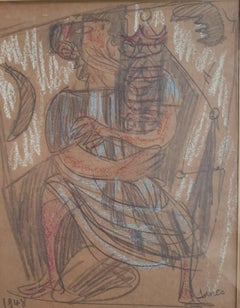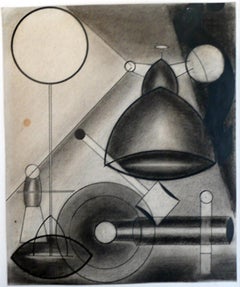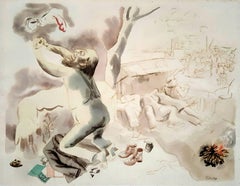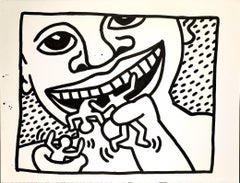Dada Drawings and Watercolor Paintings
to
3
3
3
2
3
2
Overall Height
to
Overall Width
to
5,359
1,708
1,402
1,268
538
408
272
261
182
75
50
49
7
6
4
3
2
2
2
1
1
5
1
3
2
2
2
3
3
3
1
1
Style: Dada
Period: 20th Century
Dancing Hassid
By Marcel Janco
Located in Tel Aviv - Jaffa, IL
Original mixed media on paper
Combining pastel, watercolor and pencil
Hand signed and dated lower right
Unique piece
Category
1940s Dada Drawings and Watercolor Paintings
Materials
Oil Pastel, Watercolor, Pencil
No title
By Marcel Janco
Located in Tel Aviv - Jaffa, IL
Original ink on paper
Hand signed lower right
Unique piece
Category
1940s Dada Drawings and Watercolor Paintings
Materials
Ink
Christus am Oelberg - Christ on the Mount of Olives
By George Grosz
Located in Miami, FL
This work is accompanied by a Photo-certificate and essay from Ralph Jentsch who will include it in his forthcoming catalogue raisonné
Signed lower right.
Estate stamp on ...
Category
1930s Dada Drawings and Watercolor Paintings
Materials
Watercolor, Ink
Composition in charcoal of a light with objects and a football Kurt Schwitters
By Thijs Rinsema
Located in Brookville, NY
Working with Kurt Schwitters from the Dada school of art this composition of a light with various objects and a football done in charcoal is a wonderfu...
Category
1930s Dada Drawings and Watercolor Paintings
Materials
Charcoal
Christus am Oelberg - Christ on the Mount of Olives
By George Grosz
Located in Miami, FL
This work is accompanied by a Photo-certificate and essay from Ralph Jentsch who will include it in his forthcoming catalogue raisonné
Signed lower right.
Estate stamp on verso...
Category
1930s Dada Drawings and Watercolor Paintings
Materials
Watercolor, Ink
Related Items
Untitled, 1982 (Cannibal)
By Keith Haring
Located in Greenwich, CT
Untitled, 1982 is a sumi ink on paper, 38.25 x 50" image size, signed and dated verso 'SEPT.21 - 82 + K. Haring' and framed in a custom, gold-leaf frame.
Haring’s image of a man-eating monster is partly influenced by the artist Hieronymus Bosch as Haring often cited Bosch’s The Garden of Earthly...
Category
1980s Dada Drawings and Watercolor Paintings
Materials
Paper, Sumi Ink
The Abduction of the Sabine Women , a Renaissance drawing by Biagio Pupini
Located in PARIS, FR
This vigorous drawing has long been attributed to Polidoro da Caravaggio: The Abduction of the Sabine Women is one of the scenes that Polidoro depicted between 1525 and 1527 on the façade of the Milesi Palazzo in Rome. However, the proximity to another drawing inspired by this same façade, kept at the Ecole des Beaux-Arts, and to other drawings inspired by Polidoro kept at the Musée du Louvre, leads us to propose an attribution to Biagio Pupini, a Bolognese artist whose life remains barely known, despite the abundant number of drawings attributed to him.
1. Biagio Pupini, a Bolognese artist in the light of the Roman Renaissance
The early life of Biagio Pupini, an important figure of the first half of the Cinquecento in Bologna - Vasari mentions him several times - is still poorly known. Neither his date of birth (probably around 1490-1495) nor his training are known. He is said to have been a pupil of Francesco Francia (1450 - 1517) and his name appears for the first time in 1511 in a contract with the painter Bagnacavallo (c. 1484 - 1542) for the frescoes of a church in Faenza. He then collaborated with Girolamo da Carpi, at San Michele in Bosco and at the villa of Belriguardo.
He must have gone to Rome for the first time with Bagnacavallo between 1511 and 1519. There he discovered the art of Raphael, with whom he might have worked, and that of Polidoro da Caravaggio. This first visit, and those that followed, were the occasion for an intense study of ancient and modern art, as illustrated by his abundant graphic production.
Polidoro da Caravaggio had a particular influence on the technique adopted by Pupini. Executed on coloured paper, his drawings generally combine pen, brown ink and wash with abundant highlights of white gouache, as in the drawing presented here.
2. The Abduction of the Sabine Women
Our drawing is an adaptation of a fresco painted between 1525 and 1527 by Polidoro da Caravaggio on the façade of the Milesi Palace in Rome. These painted façades were very famous from the moment they were painted and inspired many artists during their stay in Rome. These frescoes are now very deteriorated and difficult to see, as the palace is in a rather narrow street.
The episode of the abduction of the Sabine women (which appears in the centre of the photo above) is a historical theme that goes back to the origins of Rome and is recounted both by Titus Livius (Ab Urbe condita I,13), by Ovid (Fasti III, 199-228) and by Plutarch (II, Romulus 14-19). After killing his twin brother Romus, Romulus populates the city of Rome by opening it up to refugees and brigands and finds himself with an excess of men. Because of their reputation, none of the inhabitants of the neighbouring cities want to give them their daughters in marriage. The Romans then decide to invite their Sabine neighbours to a great feast during which they slaughter the Sabines and kidnap their daughters.
The engraving made by Giovanni Battista Gallestruzzi (1618 - 1677) around 1656-1658 gives us a good understanding of the Polidoro fresco, allowing us to see how Biagio Pupini reworked the scene to extract this dynamic group.
With a remarkable economy of means, Biagio Pupini takes over the left-hand side of the fresco and depicts in a very dense space two main groups, each consisting of a Roman and a Sabine, completed by a group of three soldiers in the background (which seems to differ quite significantly from Polidoro's composition).
The balance of the drawing is based on a very strongly structured composition. The drawing is organised around a median vertical axis, which runs along both the elbow of the kidnapped Sabine on the left and the foot of her captor, and the two main diagonals, reinforced by four secondary diagonals. This diamond-shaped structure creates an extremely dynamic space, in which centripetal movements (the legs of the Sabine on the right, the arm of the soldier on the back at the top right) and centrifugal movements (the arm of the kidnapper on the left and the legs of the Sabine he is carrying away, the arm of the Sabine on the right) oppose each other, giving the drawing the appearance of a whirlpool around a central point of support situated slightly to the left of the navel of the kidnapper on the right.
3. Polidoro da Caravaggio, and the decorations of Roman palaces
Polidoro da Caravaggio was a paradoxical artist who entered Raphael's (1483 - 1520) workshop at a very young age, when he oversaw the Lodges in the Vatican. Most of his Roman work, which was the peak of his career, has disappeared, as he specialised in facade painting, and yet these paintings, which are eminently visible in urban spaces, have influenced generations of artists who copied them abundantly during their visits to Rome.
Polidoro Caldara was born in Caravaggio around 1495-1500 (the birthplace of Michelangelo Merisi, known as Caravaggio, who was born there in 1571), some forty kilometres east of Milan. According to Vasari, he arrived as a mason on the Vatican's construction site and joined Raphael's workshop around 1517 (at the age of eighteen according to Vasari). This integration would have allowed Polidoro to work not only on the frescoes of the Lodges, but also on some of the frescoes of the Chambers, as well as on the flat of Cardinal Bibiena in the Vatican.
After Raphael's death in 1520, Polidoro worked first with Perin del Vaga before joining forces with Maturino of Florence (1490 - 1528), whom he had also known in Raphael's workshop. Together they specialised in the painting of palace façades. They were to produce some forty façades decorated with grisaille paintings imitating antique bas-reliefs.
The Sack of Rome in 1527, during which his friend Maturino was killed, led Polidoro to flee first to Naples (where he had already stayed in 1523), then to Messina. It was while he was preparing his return to the peninsula that he was murdered by one of his assistants, Tonno Calabrese, in 1543.
In his Vite, Vasari celebrated Polidoro as the greatest façade decorator of his time, noting that "there is no flat, palace, garden or villa in Rome that does not contain a work by Polidoro". Polidoro's facade decorations, most of which have disappeared as they were displayed in the open air, constitute the most important lost chapter of Roman art of the Cinquecento. The few surviving drawings of the painter can, however, give an idea of the original appearance of his murals and show that he was an artist of remarkable and highly original genius.
4. The façade of the Milesi Palace
Giovanni Antonio Milesi, who commissioned this palace, located not far from the Tiber, north of Piazza Navona, was a native of the Bergamo area, like Polidoro, with whom he maintained close friendly ties. Executed in the last years before the Sack of Rome, around 1526-1527, the decoration of Palazzo Milesi is considered Polidoro's greatest decorative success.
An engraving by Ernesto Maccari made at the end of the nineteenth century allows us to understand the general balance of this façade, which was still well preserved at the time. The frescoes were not entirely monochrome, but alternated elements in chiaroscuro simulating marble bas-reliefs and those in ochre simulating bronze and gold vases...
Category
16th Century Dada Drawings and Watercolor Paintings
Materials
Ink, Gouache, Pen
I Want Pizza by Daniel Johnston Ink on paper
Located in Austin, US
I Want Pizza by Daniel Johnston
original ink on paper
measures 8.5" x 11"
Est. late 1970s
Signed au recto in ink by the artist
In excellent condition for its age with no rips on the paper
This drawing was part of Power Pathos, a 2006 Station Museum of Contemporary Art (Houston, TX) exhibit showcasing the work of five artists: Ron English, Clark Fox...
Category
Late 20th Century Dada Drawings and Watercolor Paintings
Materials
Ink
"Frank Sinatra"
Located in Lambertville, NJ
Jim's of Lambertville Fine Art Gallery is proud to present this piece by Albert Hirschfeld (1903 – 2003).
At the age of 12, Albert Hirschfeld, the famed caricaturist who depicted figures in the New York theater...
Category
1960s Dada Drawings and Watercolor Paintings
Materials
Paper, Ink
“Ski Style 1960”
Located in Southampton, NY
Here for your consideration is an original mixed media fashion illustration by the world renowned fashion artist, Kenneth Paul Block. Signed with initials bottom right. Circa 1965. ...
Category
1960s Dada Drawings and Watercolor Paintings
Materials
Oil Pastel, Watercolor, Archival Paper
Untitled (Queen of Hearts with Dog on Leash)
Located in Palm Desert, CA
A drawing by Keith Haring. ""Untitled (Queen of Hearts with Dog on Leash)"" is a figurative drawing, ink on illustration board by American Pop Artist Keith Haring. The artwork is uns...
Category
Mid-20th Century Dada Drawings and Watercolor Paintings
Materials
Ink
Original Ronald Shap figure drawing, signed
Located in Columbus, OH
Original oil pastel and gouache figure drawing by celebrated, twentieth-century California landscape painter, Ronald Shap. Evocative sketch of a kneeling m...
Category
1980s Dada Drawings and Watercolor Paintings
Materials
Oil Pastel, Gouache
"Do you need me?"
Located in VÉNISSIEUX, FR
Dear art lover,
This artwork makes part of my series dedicated to " Women" and in particularly celebrates a special bond and connection between women.
This artwork called "Do you...
Category
2010s Dada Drawings and Watercolor Paintings
Materials
Watercolor, Oil Pastel
Mid Century Gouache and Oil Pastel Figurative Painting 1960s Bay Area Female Art
Located in Arp, TX
Gloria Dudfield
Yellow Purple Figure
1960s
Oil Pastel and Gouache on Paper
36"x28" unframed $800
*Custom framing available for additional charge. Please ...
Category
Mid-20th Century Dada Drawings and Watercolor Paintings
Materials
Oil Pastel, Paper, Gouache
Mid Century "Driver with Hard Hat" Gouache and Oil Pastel Figurative 1960s SF
Located in Arp, TX
Gloria Dudfield
Driver with Hard Hat
1960s
Gouache and Oil Pastel on Paper
27"x36" unframed $700
*Custom framing available for additional charge. Please expec...
Category
Mid-20th Century Dada Drawings and Watercolor Paintings
Materials
Oil Pastel, Paper, Gouache
"Frank Sinatra and Shirley MacLaine at Radio City Music Hall"
Located in Lambertville, NJ
Jim's of Lambertville Fine Art Gallery is proud Albert Hirschfeld (1903 – 2003)
At the age of 12, Albert Hirschfeld, the famed caricaturist who depicted figures in the New York theater...
Category
1960s Dada Drawings and Watercolor Paintings
Materials
Paper, Ink
"Ranger", 1937 America's Cup Winner J-Class Racing Yacht Sailboat Ink on Paper
Located in Clermont-Ferrand, Auvergne-Rhône-Alpes
This artwork depicts the Ranger, last J-class racing yacht to race for the America's Cup, defeating the Endeavour II in 1937.
The artist can draw custom designs on demand, feel free...
Category
2010s Dada Drawings and Watercolor Paintings
Materials
Ink, Paper
Dada drawings and watercolor paintings for sale on 1stDibs.
Find a wide variety of authentic Dada drawings and watercolor paintings available for sale on 1stDibs. Works in this style were very popular during the 21st Century and Contemporary, but contemporary artists have continued to produce works inspired by this movement. Many Pop art paintings were created by popular artists on 1stDibs, including Marcel Janco, George Grosz, and Jolynn Reigeluth. Frequently made by artists working with Ink, and Paint and other materials, all of these pieces for sale are unique and have attracted attention over the years. Not every interior allows for large Dada drawings and watercolor paintings, so small editions measuring 5.91 inches across are also available. Prices for drawings and watercolor paintings made by famous or emerging artists can differ depending on medium, time period and other attributes. On 1stDibs, the price for these items starts at $750 and tops out at $37,000, while the average work sells for $3,000.
Recently Viewed
View AllMore Ways To Browse
Japanese Watercolor Panel
Bath Poster
Palm Tree Watercolor
Dior Top Mens
Gay Vintage Drawings
Thousand Of Nights
Basquiat Green
Russian Interior Watercolors
New Zealand Watercolor
Santa Fe Chairs
Bennett Tom
Antique Watercolour Box
Antique Watercolour Boxes
Antique Watercolor Boxes
Antique Watercolor Box
Antique Watercolour Box Boxes
Antique Watercolor Box Boxes
Joan Miro Watercolor






